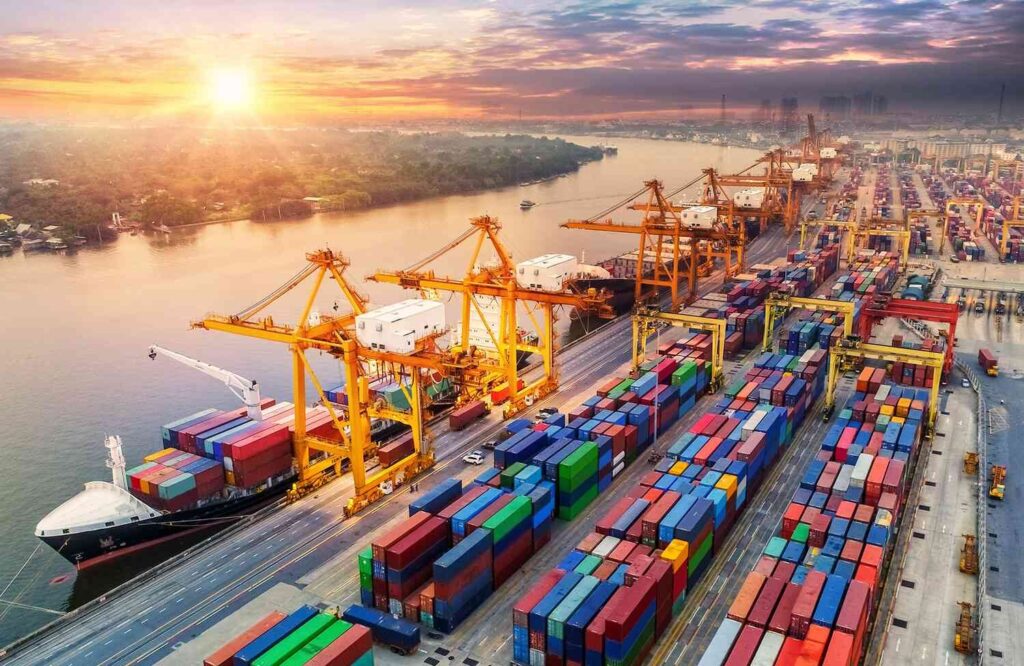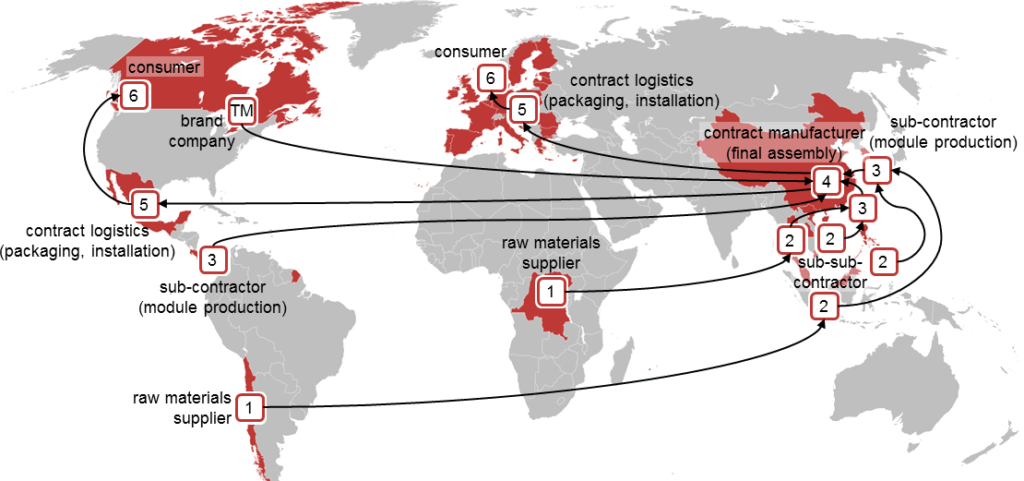China is the world’s largest exporter and the second-largest importer of goods, with a total trade value of $4.6 trillion in 2023. The US is China’s largest trading partner, accounting for 17.5% of China’s total exports and 8.5% of its total imports. In 2023, the US imported $560 billion worth of goods from China, making it the biggest import from China to the US.
Top Imports from China to the US

The top imports from China to the US in 2023 were as follows:
- Electrical machinery and equipment: $152 billion (27.1% of total imports)
- Machinery and mechanical appliances: $117 billion (20.9% of total imports)
- Furniture and bedding: $35 billion (6.3% of total imports)
- Toys, games, and sports equipment: $27 billion (4.8% of total imports)
- Plastics and articles thereof: $19 billion (3.4% of total imports)
Other major imports from China to the US included footwear, apparel, optical and medical instruments, vehicles, and iron and steel.
Impact of China’s Imports on the US Economy
China’s imports have a significant impact on the US economy, both positive and negative. On the positive side, China’s imports provide the US consumers with a variety of low-cost and high-quality goods, which increase their purchasing power and living standards. China’s imports also create demand for US exports, such as agricultural products, services, and high-tech goods, which support US jobs and industries. China’s imports also contribute to the global supply chain, which enhances the efficiency and competitiveness of US firms.
On the negative side, China’s imports also pose challenges and threats to the US economy, such as trade deficits, job losses, environmental issues, and national security risks. China’s imports have contributed to the US trade deficit, which reached $310 billion in 2023, the largest among all trading partners. China’s imports have also displaced some US domestic production, especially in labor-intensive sectors such as manufacturing, textiles, and furniture, which have resulted in job losses and wage stagnation for some US workers. China’s imports have also raised environmental concerns, as some of the goods may not meet the US standards for safety, quality, and emissions. China’s imports have also raised national security concerns, as some of the goods may contain sensitive or critical technologies, materials, or components that could pose a threat to the US interests or allies.
Trade Policies and Tariffs Affecting China-US Imports

The trade relationship between China and the US has been marked by tensions and disputes over various issues, such as intellectual property rights, market access, currency manipulation, human rights, and cybersecurity. In recent years, the trade conflict has escalated into a trade war, with both sides imposing tariffs and other measures on each other’s goods.
The trade war started in 2018, when the US imposed tariffs on $50 billion worth of Chinese imports, citing China’s unfair trade practices and theft of intellectual property. China retaliated with tariffs on $50 billion worth of US imports. The US then imposed tariffs on another $200 billion worth of Chinese imports, and China responded with tariffs on another $60 billion worth of US imports. The US then increased the tariff rate on the $200 billion worth of Chinese imports from 10% to 25%, and threatened to impose tariffs on the remaining $300 billion worth of Chinese imports. China then increased the tariff rate on the $60 billion worth of US imports from 5% to 25%, and announced plans to create an “unreliable entities list” to target US firms that harm China’s interests.
In 2019, the two sides agreed to a “phase one” trade deal, which suspended the planned tariffs and reduced some of the existing tariffs. The deal also included commitments from China to increase its purchases of US goods and services, protect intellectual property rights, open its market for financial services, and refrain from currency manipulation. However, the deal did not address some of the structural issues, such as China’s industrial policies, subsidies, and state-owned enterprises, that the US considers unfair and harmful.
In 2020, the trade war was overshadowed by the COVID-19 pandemic, which disrupted the global trade and economy. The pandemic also worsened the bilateral relations, as the US blamed China for the origin and spread of the virus, and China accused the US of politicizing and stigmatizing the issue. The two sides also clashed over other issues, such as Hong Kong, Taiwan, Xinjiang, and the South China Sea, which further strained the trade ties.
In 2021, the new US administration under President Joe Biden took office, and signaled a shift in the trade policy towards China. The Biden administration indicated that it would review the existing tariffs and trade deal, and seek a more multilateral and strategic approach to address the trade challenges with China. The Biden administration also emphasized the need to cooperate with China on global issues, such as climate change, public health, and non-proliferation, while competing with China on economic and security issues.
In 2022, the two sides resumed the high-level trade talks, and agreed to ease some of the trade tensions and barriers. The US removed tariffs on some of the Chinese imports, such as medical supplies, consumer goods, and agricultural products, and China reciprocated by removing tariffs on some of the US imports, such as soybeans, pork, and corn. The two sides also agreed to increase the implementation and enforcement of the phase one trade deal, and to explore the possibility of a phase two trade deal, which would address the remaining issues and concerns.
In 2023, the two sides made further progress in the trade negotiations, and announced a “phase two” trade deal, which marked the end of the trade war. The deal included the removal of all the tariffs and counter-tariffs imposed since 2018, and the restoration of the normal trade relations. The deal also included provisions on the following issues:
- Intellectual property rights: China agreed to strengthen the protection and enforcement of intellectual property rights, and to join the international agreements and conventions on the issue. China also agreed to refrain from forcing or pressuring US firms to transfer their technology or trade secrets, and to crack down on the piracy and counterfeiting of US goods.
- Market access: China agreed to further open its market for US goods and services, and to eliminate the non-tariff barriers and discriminatory practices that restrict the US market entry. China also agreed to grant the US firms the national treatment and the negative list approach, which means that the US firms can operate in any sector that is not explicitly prohibited or restricted by China.
- Industrial policies: China agreed to reform its industrial policies, and to reduce the role and influence of the state-owned enterprises, subsidies, and preferential policies that distort the market and create unfair competition. China also agreed to ensure a level playing field for the US firms, and to abide by the international rules and norms on the issue.
- Currency: China agreed to maintain a market-determined exchange rate for its currency, and to refrain from manipulating or intervening in the currency market for competitive advantage. China also agreed to increase the transparency and accountability of its currency policy, and to cooperate with the US and other countries on the issue.
- Dispute resolution: China and the US agreed to establish a bilateral mechanism for the dispute resolution, which would include regular consultations, dialogues, and reviews at various levels. The mechanism would also include a process for imposing or removing tariffs or other measures in case of non-compliance or violation of the trade deal.
China’s Role in the Global Supply Chain

China plays a vital role in the global supply chain, as it is the world’s largest producer and exporter of many intermediate and final goods, such as electronics, machinery, textiles, and chemicals. China is also the world’s largest consumer and importer of many raw materials, such as oil, iron ore, copper, and soybeans. China’s role in the global supply chain has increased over the years, as it has integrated with the global economy and expanded its trade and investment networks.
China’s role in the global supply chain has also brought benefits and challenges to the world, especially to the US. On the one hand, China’s role in the global supply chain has enhanced the efficiency, diversity, and resilience of the global production and distribution of goods and services. China’s role in the global supply chain has also created opportunities for the US and other countries to access the large and growing Chinese market, and to leverage the comparative advantages and complementarities of China’s production and consumption. China’s role in the global supply chain has also fostered the cooperation and interdependence among the countries, which could promote the peace and stability in the world.
On the other hand, China’s role in the global supply chain has also posed risks and challenges to the world, especially to the US. China’s role in the global supply chain has also exposed the vulnerabilities and dependencies of the global production and distribution of goods and services. China’s role in the global supply chain has also created competition and conflicts for the US and other countries over the access and control of the scarce and strategic resources, markets, and technologies. China’s role in the global supply chain has also raised concerns over the quality, safety, and security of the goods and services that originate from or transit through China. China’s role in the global supply chain has also increased the potential for the disruption and divergence of the global supply chain, which could undermine the cooperation and interdependence among the countries.
Challenges and Controversies in the China-US Trade Relationship
The trade relationship between China and the US has been fraught with challenges and controversies over various issues, such as the trade imbalance, the trade deficit, the trade surplus, the trade practices, the trade policies, and the trade impact. These issues have sparked debates and disputes among the policymakers, scholars, businesses, and publics of both countries, and have influenced the perception and attitude of each side towards the other.
One of the main challenges and controversies in the China-US trade relationship is the trade imbalance, which refers to the difference between the value of the goods and services that each side exports and imports from the other. The trade imbalance between China and the US has been large and persistent, as China has consistently exported more than it has imported from the US, resulting in a trade surplus for China and a trade deficit for the US. In 2023, China’s trade surplus with the US was $250 billion, while the US trade deficit with China was $310 billion.
The trade imbalance between China and the US has been a source of concern and complaint for the US, as it has been seen as a sign of unfairness and unsustainability in the trade relationship. The US has argued that the trade imbalance is caused by China’s unfair trade practices, such as currency manipulation, subsidies, dumping, non-tariff barriers, and intellectual property theft, which give China an artificial and illegitimate advantage over the US in the trade competition. The US has also argued that the trade imbalance is harmful to the US economy, as it reduces the US output, income, employment, and growth, and increases the US debt, inflation, and vulnerability.
The trade imbalance between China and the US has been a source of pride and satisfaction for China, as it has been seen as a sign of success and strength in the trade relationship. China has argued that the trade imbalance is caused by the market forces, such as the comparative advantages, the consumer preferences, the production costs, and the exchange rates, which reflect the natural and legitimate outcome of the trade cooperation. China has also argued that the trade imbalance is beneficial to the US economy, as it provides the US with cheap and quality goods, creates demand for US exports, supports US jobs and industries, and finances US deficits and investments.
Another challenge and controversy in the China-US trade relationship is the trade impact, which refers to the effects and consequences of the trade on the economic, social, and political aspects of both countries. The trade impact between China and the US has been mixed and complex, as it has brought both opportunities and challenges, benefits and costs, winners and losers, to both sides.
The trade impact between China and the US has been positive and negative, depending on the perspective and position of the stakeholders. On the positive side, the trade between China and the US has enhanced the economic growth, development, and welfare of both countries, by increasing the production, consumption, trade, and investment of goods and services, and by creating jobs, incomes, profits, and savings for the producers, consumers, traders, and investors. The trade between China and the US has also fostered the social and cultural exchange, understanding, and integration of both countries, by facilitating the flow of people, ideas, values, and norms, and by promoting the education, tourism, entertainment, and communication of the people. The trade between China and the US has also supported the political stability, security, and cooperation of both countries, by strengthening the economic interdependence, mutual interest, and common goal, and by reducing the potential for conflict, confrontation, and competition.
On the negative side, the trade between China and the US has also generated economic, social, and political problems and challenges for both countries, by creating imbalances, inequalities, inefficiencies, and externalities in the trade relationship. The trade between China and the US has also caused social and cultural conflicts, tensions, and divisions of both countries, by creating differences, disparities, frictions, and misunderstandings among the people, groups, and regions, and by challenging the identity, values, and norms of the societies. The trade between China and the US has also posed political risks, threats, and uncertainties for both countries, by creating competition, rivalry, and distrust over the resources, markets, and technologies, and by influencing the interests, policies, and alliances of the governments.
Opportunities for US Businesses in Chinese Imports
Despite the challenges and controversies in the trade relationship, China’s imports also offer opportunities for US businesses, as China is a large and growing market for US goods and services. China’s imports are driven by various factors, such as the economic growth, the population size, the income level, the consumption pattern, the urbanization rate, the industrial structure, and the trade policy of China. These factors create demand and potential for US businesses to export to or invest in China, especially in the following sectors:
- Services: China’s service sector is the largest and fastest-growing sector of its economy, accounting for 54.5% of its GDP and 46.3% of its employment in 2023. China’s service sector is also the most open and competitive sector of its trade, as China has liberalized and deregulated its service market, and has committed to further opening and expanding its service trade under the phase one and phase two trade deals with the US. China’s service sector offers opportunities for US businesses, as China has a huge and diverse demand for various services, such as financial, educational, health, tourism, entertainment, and professional services, and as the US has a strong and advanced service industry, with high-quality and innovative service products and providers.
- High-tech: China’s high-tech sector is the most dynamic and strategic sector of its economy, accounting for 14.2% of its GDP and 18.7% of its exports in 2023. China’s high-tech sector is also the most challenging and controversial sector of its trade, as China has pursued an ambitious and aggressive plan to develop and upgrade its high-tech industry, and has faced accusations and restrictions from the US and other countries over its trade practices and policies in the high-tech field. China’s high-tech sector offers opportunities for US businesses, as China has a strong and growing demand for high-tech goods and services, such as computers, software, telecommunications, biotechnology, aerospace, and artificial intelligence, and as the US has a leading and dominant position in the global high-tech market, with cutting-edge and innovative high-tech products and companies.
- Agriculture: China’s agriculture sector is the most traditional and important sector of its economy, accounting for 7.7% of its GDP and 22.4% of its employment in 2023. China’s agriculture sector is also the most sensitive and volatile sector of its trade, as China has faced food security and safety issues, and has experienced fluctuations and disruptions in its agricultural trade, especially with the US, due to the trade war, the pandemic, the weather, and the pests. China’s agriculture sector offers opportunities for US businesses, as China has a large and increasing demand for agricultural products, such as soybeans, corn, wheat, cotton, pork, beef, poultry, and dairy, and as the US has a competitive and reliable agricultural industry, with abundant and quality agricultural products and producers.




